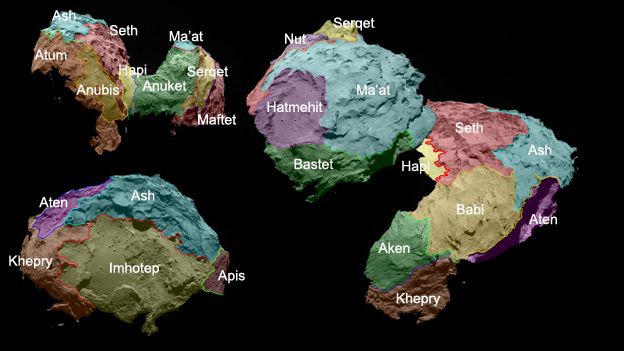Paul Doherty of the Exploratorium explains phases of the European Space Agency’s Rosetta Mission to the comet 67P/Churyumov–Gerasimenko in exquisite detail.
Comets are extremely interesting celestial objects. They may have even played role in jump starting life on our planet. When and how chemistry became biology is a burning question for everyone. There has been a period way in the past during the early times of the Earth when meteorites and comets bombarded its surface. This period is known as the Late Heavy Bombardment which also helped formation of first continents forming irregularities on the cooling crust of the Earth. Due to tectonic activity almost all marks have been erased from the surface but the evidence is visible on the Moon. It’s possible that comets brought their rich organic material and water to Earth during this period.
Cores of comets consist of ice but also contain organic chemicals like carbon dioxide, carbon monoxide, formaldehyde and methanol. In fact, the heroic Philae lander sniffed out 16 organic chemical species in its first landing site before it bounced. These molecules would have been vital for creating the first amino acids, nucleobases and sugars. NASA scientists detected the amino acid glycine in the dust of another comet called ‘Wild 2’. More excitingly, four of these chemicals were never before anticipated to exist on a comet. One of them was a huge suprise: Oxygen. Oxygen is the largest biosignature molecule on Earth. Without photosynthetic life the atmosphere would never be able to accumulate 20% oxygen. Oxygen is very reactive therefore it is perhaps the most unexpected discovery of the whole mission. Comets are old. Older than our planet. They represent original material that formed our solar system that failed to become incorporated into planets and satellites. The Rosetta Mission is fascinating project in many regards. How did oxygen survived without reacting with other chemicals? What generates it? Science will tell.
As the Rosetta probe circled around the comet it began to map its surface and eventually formed a photogrammetrical 3-D model. The model was essential to find the most suitable landing site. The mapping effort revealed that the surface is riddled with pits that formed much like sink holes here on Earth. It appears material below the surface of the icy body vaporizes in places, resulting in voids that will then no longer support the crust above.
The mapping operation also detected curious “goose bumps” on the surface. Scientists think that these features may be hinting about how the comet nucleus was formed 4.5 billion years ago. Initially, accreting gas and dust would have formed little ‘pebbles’ that grew and grew until they got up to the size of these goosebumps – about 3m in size – and for whatever reason, they couldn’t further continue their growth.
Once mapping was complete and texture broadly defined the most obvious question was about the shape of the space rubber ducky. Was it a single body whose middle section got eroded over billions of years? Or was it two separate bodies joined by a slow impact collision? Analysis of the gravity fields and unmatching layers that resemble onion skins suggested the latter. Comet 67/P was formed by a low velocity collision of two bodies.
The Philae lander revealed another interesting fact about the nature of ice on the comet. The isotopic signature of water didn’t match that of the Earth. In fact, the heavy water ratio was measured to be more than three times higher than on the Earth. If comets brought water to our planet they must be a different kind.
2015 has been a spectacular year for amazing space discoveries including Pluto fly by, confirmation of liquid water on Mars and mapping of Ceres the largest object in the asteroid belt by the Dawn spacecraft. Observations from 67/P is most certainly one of them with great astrobiological importance.



0 Comments
You can be the first one to leave a comment.